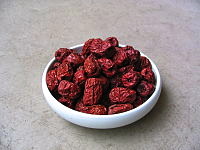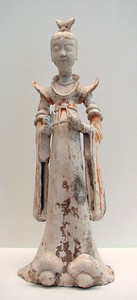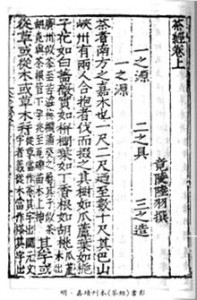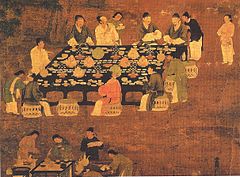Chinese Cuisine

Chinese Food: A Brief history
History of Chinese Cuisine
The Cuisine of China spreads both around the world and deep into history and is marked by both variety and change. The archeologist and scholar K.C. Chang says “Chinese people are especially preoccupied with food” and “food is at the center of, or at least it accompanies or symbolizes, many social interactions.” Over the course of history, he says, “continuity vastly outweighs change.” He posits basic organizing principles which go back to earliest times and give a continuity to the food tradition, principally that a normal meal is made up of fan (grains and other starches) and cai (vegetable or meat dishes). Others see a succession of changes and development which bring incremental but basic change. Endymion Wilkinson offers four keys to the “richness of ever-changing Chinese cuisine:”The philosopher and writer Lin Yutang is more relaxed:
- “How a Chinese spirit glows over a good feast! How apt is he to cry out that life is beautiful when his stomach and his intestines are well filled! From this well filled stomach suffuses and radiates a happiness that is spiritual. The Chinese relies upon instinct and his instinct tells him that when the stomach is right, everything is right. That is why I claim for the Chinese a life closer to instinct and a philosophy that makes a more open acknowledgment of it possible.”
- Practices
Over the centuries, as new food sources and techniques were invented, the Chinese cuisine as we know it gradually evolved. The “Silk road” is the conventional term for the routes through Central Asia linking the Iranian plateau with western China; along this trade route passed exotic foodstuffs that greatly enlarged the potential for Chinese cuisines, only some of which preserve their foreign origin in the ideogram for “foreign” that remains in their name: “it would surprise many Chinese cooks to know that some of their basic ingredients were originally foreign imports,” Frances Wood observes: sesame, peas, onions, coriander from Bactria, and cucumber were all introduced into China from the West during the Han dynasty“. Chopsticks, which are made from all sorts of materials and which are one of the hallmarks of the Chinese table, have been used as eating utensils at least as far back as the Zhou Dynasty. Stir-fried dishes became popular during the Tang Dynasty. The stir-fry method of cooking was invented out of necessity, in order to conserve expensive and scarce fuel.
Chinese cuisine classifications
Not long after the expansion of the Chinese Empire during the Qin Dynasty and Han Dynasty, Chinese writers noted the great differences in culinary practices among people from different parts of the realm. These differences followed to a great extent the varying climate and availability of foodstuffs in China. Different ethnic groups might occupy only small areas, but early on, their cuisines were included in systematic lists of Chinese cuisines. China’s cuisines are classified as follows:
North and south
The difference between northern and southern cuisines was one of the earliest distinctions that was noted, and one that is still observed today even as the food cultures of North and South China have evolved greatly since the distinction was first made. Northerners generally eat wheat-based foods, southerners eat rice-based foods.
Traditional Four Schools classifications
Most Chinese cuisines belong to one of the Four Schools: Lu, Yang (named after Jiangsu‘s major style, Huaiyang cuisine), Chuanand Yue. These are often translated as the cuisines of Shandong, Sichuan, Jiangsu and Guangdong. The School of Lu (Shandong) is the largest because it is the oldest.
The Eight Schools classification
The Eight Schools include the four major branches of the “Four Schools” and add the following: Hunan, Fujian, Anhui and Zhejiang.
History – Neolithic
Lajia (Chinese: 喇家; Pinyin: Lǎjiā) is an archaeological site located in Minhe County, Haidong Prefecture in Northwest China‘s Qinghai province. Lajia is associated with the Qijia culture and was discovered by archaeologists in 2000. The site covers an area of around 200,000 square meters. Archaeologists believe the site was abandoned after being devastated by an earthquake and subsequent flood. In 2005, the oldest intact noodles yet discovered were located at Lajia, estimated at over 4,000 years old. The noodles were made from millet. In October 2005, the oldest noodles yet discovered were found at the Lajia site (Qijia culture) along the Yellow River in Qinghai, China. The 4,000-year-old noodles appear to have been made from foxtail millet and broomcorn millet.
Early dynastic times
There has always been a major class difference between the royalties and the regular citizens living outside the imperial quarters. Beijing was not always the capital of China. In fact the geography of the far northeastern corner of China with its long, harsh winters with limited agricultural possibilities, has always posed serious water and food supply problems.
The most common staple crops consumed during the Han Dynasty (202 BC–220 AD) were wheat, barley, rice, foxtail millet, proso millet and beans. Commonly-eaten fruits and vegetables included chestnuts, pears, plums, peaches, melons, apricots, red bayberries, jujubes, calabash, bamboo shoots, mustard plant and taro. Domesticated animals that were also eaten included chickens, Mandarin ducks, geese, cows, sheep, pigs, camels and dogs. Turtles and fish were taken from streams and lakes. Commonly-hunted game, such as owl, pheasant, magpie, sika deer, and Chinese Bamboo Partridge were consumed. Seasonings included sugar, honey, salt and soy sauce. Beer and wine were regularly consumed.
Tang Dynasty – Further information: Tang Dynasty A terracotta sculpture of a woman, 7th–8th century; during the Tang era, female hosts prepared feasts, tea parties, and played drinking games with their guests.
A terracotta sculpture of a woman, 7th–8th century; during the Tang era, female hosts prepared feasts, tea parties, and played drinking games with their guests.
 A page of Lu Yu‘s Classic of Tea
A page of Lu Yu‘s Classic of Tea
 Dried jujubes such as these were imported to Song China from South Asia and the Middle East. An official from Canton was invited to the home of an Arab merchant, and described the jujube as thus: “This fruit is the color of sugar, its skin and its pulp are sweet, and it gives the impression, when you eat it, of having first been cooked in the oven and then allowed to dry.”
Dried jujubes such as these were imported to Song China from South Asia and the Middle East. An official from Canton was invited to the home of an Arab merchant, and described the jujube as thus: “This fruit is the color of sugar, its skin and its pulp are sweet, and it gives the impression, when you eat it, of having first been cooked in the oven and then allowed to dry.”
- From the Song period, there are many surviving lists of names for entrées and food dishes in customer. The memory and patience of waiters had to be keen; in the larger restaurants, serving dinner parties that required twenty or so dishes became a hassle if even a slight error occurred.
If a guest reported the mistake of a waiter to the head of the restaurant, the waiter could be verbally reprimanded, have his salary docked, or in extreme cases, kicked out of the establishment for good.
 A Chinese painting of an outdoor banquet, a Song Dynasty painting and possible remake of a Tang Dynasty original.
A Chinese painting of an outdoor banquet, a Song Dynasty painting and possible remake of a Tang Dynasty original.
In the early morning in Hangzhou, along the wide avenue of the Imperial Way, special breakfast items and delicacies were sold. This included fried tripe, pieces of mutton or goose, soups of various kinds, hot pancakes, steamed pancakes, and iced cakes. Noodle shops were also popular, and remained open all day and night along the Imperial Way. According to one Song Dynasty source on Kaifeng, the night markets closed at the third night watch but reopened on the fifth, while they had also gained a reputation for staying open during winter storms and the darkest, rainiest days of winter. There were also some exotic foreign foods imported to China from abroad, including raisins, dates, Persian jujubes, and grape wine; rice wine was more common in China, a fact noted even by the 13th century Venetian traveler Marco Polo. Although grape-based wine had been known in China since the ancient Han Dynasty Chinese ventured into Hellenstic Central Asia, grape-wine was often reserved for the elite. Besides wine, other beverages included pear juice, lychee fruit juice, honeyand ginger drinks, tea, and pawpaw juice. Dairy products and farming were foreign concepts to the Chinese, which explains the absence of cheese and milk in their diet. Beef was also rarely eaten, since the bull was an important draft animal. The main consumptionary diet of the lower classes remained rice, pork, and salted fish, while it is known from restaurant dinner menus that the upper classes did not eat dog meat. The rich are known to have consumed an array of different meats, such as chicken, shellfish, fallowdeer, hares, partridge, pheasant, francolin, quail, fox, badger, clam, crab, and many others. Local freshwater fish from the nearby lake and river were also caught and brought to market, while the West Lake provided geese and duck as well. Common fruits that were consumed included melons, pomegranates, lychees, longans, golden oranges, jujubes, quinces, apricots and pears; in the region around Hangzhou alone, there were eleven kinds of apricots and eight different kinds of pears that were produced. Specialties and combination dishes in the Song period included scented shellfish cooked in rice-wine, geese with apricots, lotus-seed soup, pimento soup with mussels and fish cooked with plums, sweet soya soup, baked sesame buns stuffed with either sour bean filling or pork tenderloin, mixed vegetable buns, fragrant candied fruit, strips of ginger and fermented beanpaste, jujube-stuffed steamed dumplings, fried chestnuts, salted fermented bean soup, fruit cooked in scented honey, and ‘honey crisps’ of kneaded and baked honey, flour, mutton fat and pork lard. Dessert molds of oiled flour and sugared honey were shaped into girls’ faces or statuettes of soldiers with full armor like door guards, and were called “likeness foods” (guoshi). Su Shi a famous poet and statesmen at the time also wrote extensively on the food and wine of the period. The legacy of his appreciation of food and gastronomy, as well as his popularity with the people can be seen in Dongpo pork, a dish said to be created and named after him. An influential work which recorded the cuisine of this period is Shanjia Qinggong (山家清供 The Simple Foods of the Mountain Folk) by Lin Hong (林洪). This recipe book accounts the preparation of numerous dishes of common and fine cuisines.

